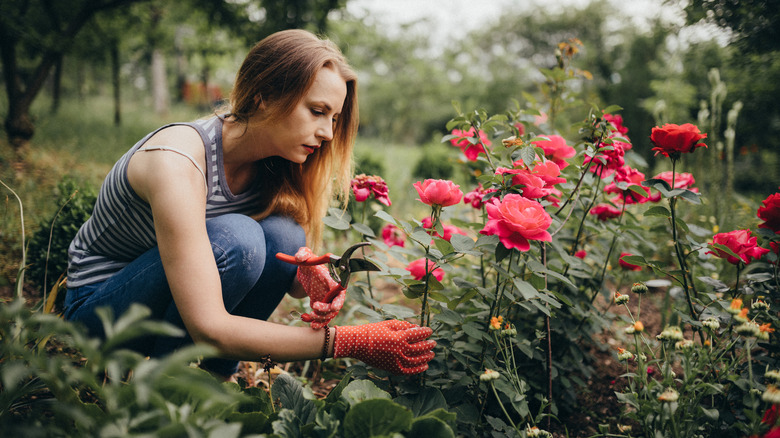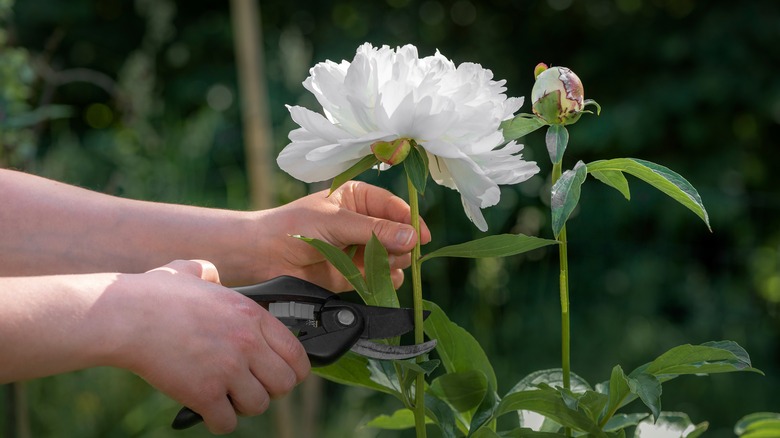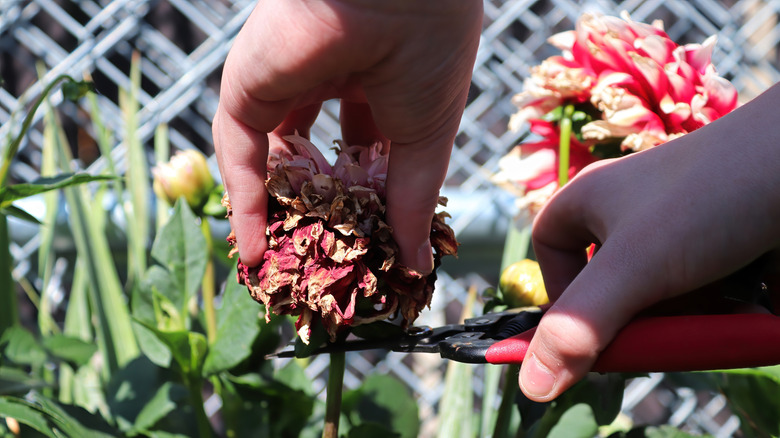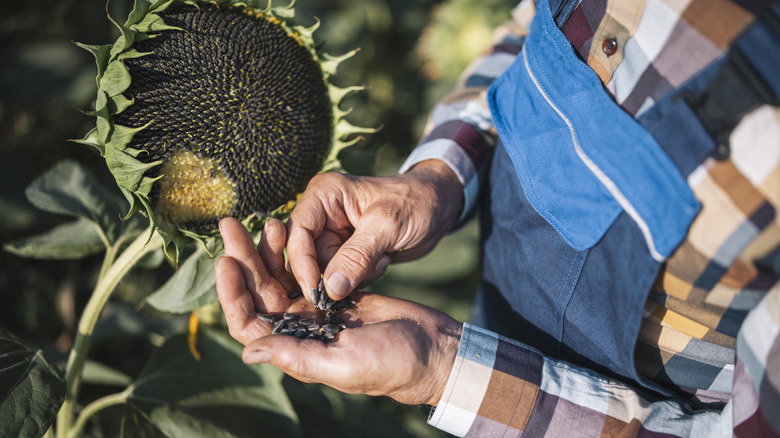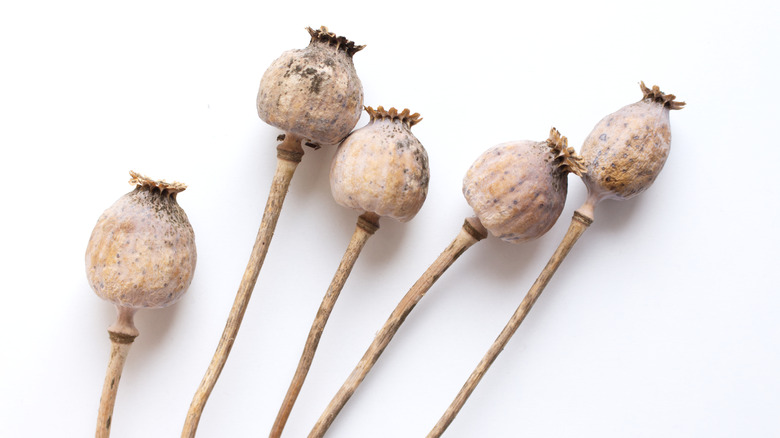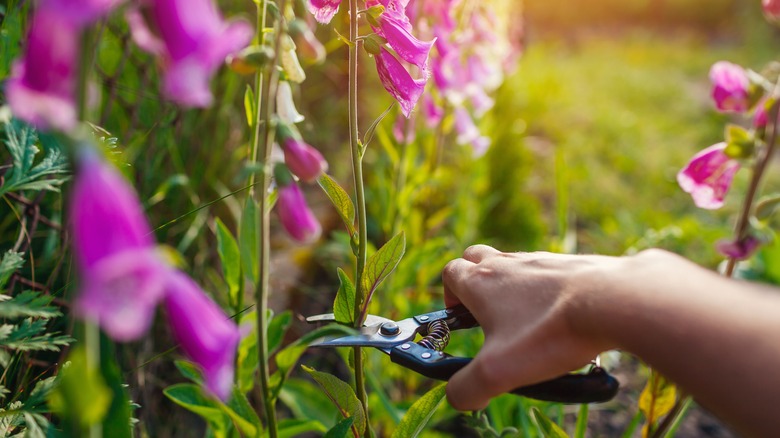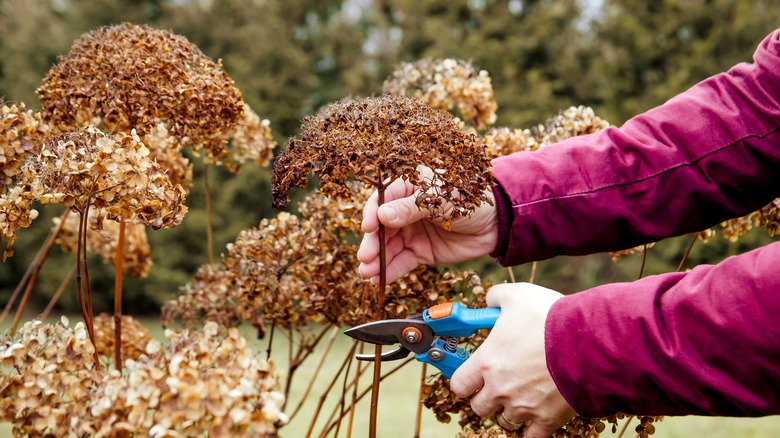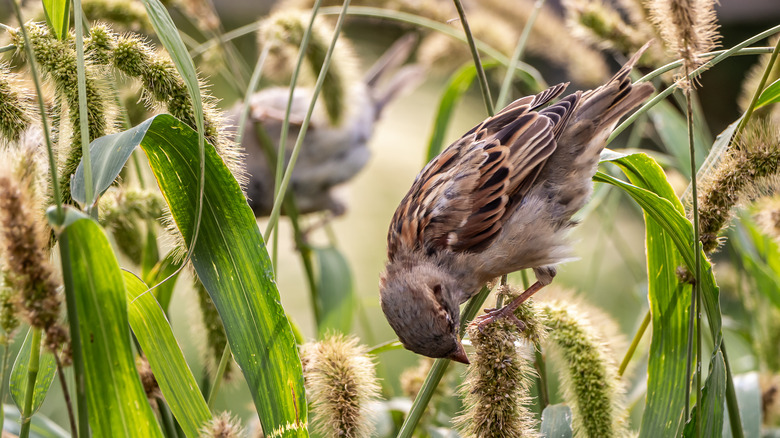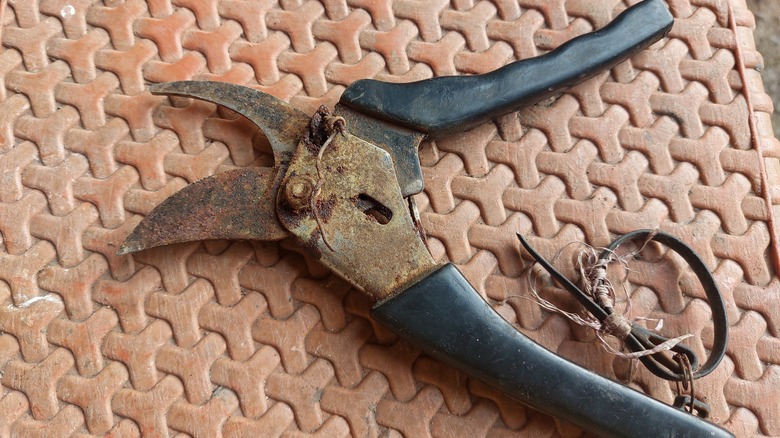Mistakes To Avoid When Deadheading Your Garden's Flowers
Professionals and hobbyists alike will tell you that the practice of deadheading in the garden is a must for anyone looking to get the most blossoms possible throughout the season. By gently removing spent blooms with pinched fingers or cutting shears a few inches below the old flowers, you can set up your plants to bloom again. It's a way to keep your garden full of gorgeous color, and it's also a practical step in stopping the overactive self-seeders from taking over the entire yard.
Of course, as with any task that involves our precious plants, there's a laundry list of ways to mess it up. However, most of the common mistakes that even experienced gardeners make are not so terrible that they'll result in the death of your flowers. That said, let's take a look at the ones we can easily avoid with just a little patience and some general knowledge about maintenance techniques.
Cutting too far down on the stem
One of the first things to understand about proper deadheading is exactly where to make your cut. Some gardeners may argue that there's a perfect spot for each type of flower, but that can quickly get overwhelming. Luckily there is a general guideline that works for most. Position your clean and sharp cutting shears below the top bloom and then slide them down until they are just above the next leaf node. That's where you make your cut: about ¼ inch above the leaf node (which may alternatively be the next flower or a bud). Cutting farther down the stem can result in unintentional damage; it's primarily the new growth you might be removing. Then you'll end up with a bare stem that cannot produce any more flowers.
If you're nervous about making cuts with sharp secateurs, you can just use your fingers to pinch away the spent blooms. The most important piece of the puzzle is making sure you don't destroy that delicate new growth.
Deadheading everything all at once
Ultimately, deadheading should be performed on a rolling basis throughout the season, depending on the needs of individual plants. Going all out and deadheading every bloom from an entire plant can potentially force it into a state of shock from stress and dehydration. A little extra water or a nutrient-boosting spritz from a foliar spray fertilizer may help if you've accidentally done this.
At the same time, you might have some plants already stressed due to other issues. Make sure you're letting them come back to life before hitting them up with the pruning shears. It's of little benefit to deadhead a plant struggling from a nutrient deficiency or pest problem because it can add to the stress, since the plant has to divert energy to heal the cuts. Deadheading as a practice encourages extra blooms, but it doesn't actually improve the overall health of your plants. Better to leave them alone until they're stronger.
Forgetting to save seeds for next season
Before you start the deadheading process, it's a good idea to think through your gardening plan for next season. Which plants did well, and which ones would you prefer not to bring back? If you plan to become an avid gardener, seed saving is a great practice to get into, and not only because it'll save you some money in the long run. You can also choose seeds from your healthiest, biggest, most attractive flowers, allowing you to reproduce a better flower patch the following year.
As you survey your plot looking for the strongest, highest-yielding plants, note them as the ones you'll let go to seed rather than deadheading. Head out into the garden about a month after the flowers have died off. Pick a sunny day and wait for any dew to evaporate before you begin collecting. As you separate the seeds from the chaff, keeping track of what is what will be very important. Use sealable or paper bags, and label them all clearly with a permanent marker. Then make sure you have a dark, dry, cool area in the house where you can tuck everything away until next year.
Missing out on ornamental seed heads
Oh, the many arts and crafts possibilities in the glorious dried seed pod! Holiday table centerpieces, wreaths, Mason jar bouquets — where does it end? It would certainly be a pity if you cleaned out every nook and cranny of your garden and missed out on the beauty of ornamental seed pods and heads. It's also worth noting that it's not just arts and crafts projects that can be elevated by the natural beauty of dried flower heads; your entire garden can benefit from a swath of winter interest if you know which plants to include.
Globe thistles offer adorable blue pompoms. The spiked seed heads of 'Silver Ghost' sea holly turn to shimmery silver. Some seed pods have distinctive shapes, and others create texture. Beauty is in the eye of the beholder when the landscape turns barren and the cold winds and snowflakes hit our cheeks. But many of the once bright and beautiful blooming flowers in the garden will still offer a distinct and delightful splash of artistry.
Cutting the wrong plants
Deadheading works for most flower species, but decidedly not all. Some perennials, for example, depend on self-seeding to be productive the following season. These include foxgloves, hollyhocks, cardinal flowers, and forget-me-nots. Cut them for fresh flower bouquets, but leave them alone when it comes to deadheading. Others, like cosmos and geraniums, are naturally prolific bloomers who don't need to be deadheaded.
Other types of plants that do not require any help with their own maintenance belong to a group called self-cleaning plants. Either they don't produce seeds, or their petals drop off their own accord when ready to go. These plants make great choices for hanging baskets so you won't have to strain to reach them to remove spent blooms. From begonias to petunias, you can find a wide array of splashy colors to brighten up your yard or patio without worrying about keeping them tidy.
Starting too late in the season
We often think of deadheading as an end-of-season clean-up chore, but certain flowers will benefit from the practice all summer long. And if you start too late in the season, then you risk stalling these prolific bloomers. Did you even realize that many of your annual flowers can re-bloom in the same season? It's true that they won't be returning next year, but you should be able to keep them going strong from spring to fall.
Timing the deadheading comes into play because it encourages faster re-blooming. Why settle for one or two rounds of flowers if you can have three or even four? If the flowers are left in place, then the plant understands that the next thing to do is start making seeds. When spent blooms are removed, the plant instead gets a signal to go back to flower production. You can start tending to your flowers this way towards the end of spring, and be prepared to do it often, even as much as every few days. Consider also that if you wait until the end of the season, it will be an enormous task rather than a delightful excuse to spend a few minutes a day exploring your exquisite garden.
Stealing potential food from winter wildlife
We've talked about all the benefits of deadheading for the health of individual plants, but what about the health of the greater ecosystem of your yard and neighborhood? One reason to consider going light on the deadheading is that many insects, birds, and ground-dwelling animals depend on the seed pods for food throughout the harsh winter months. Cardinals, chickadees, goldfinches, and sparrows are just some of the many granivorous (seed-eating) birds that will happily graze your garden after a snowfall. Some prefer sunflower seeds, while others will seek out the coreopsis and black-eyed Susans.
By deadheading every single stalk in the garden, you're unnecessarily taking away all of that potential food from the wildlife who depend on it. It's okay if you feel drawn to clean up the early season bloomers, but think about letting some fall blooming perennials like asters, goldenrod, mums, and Joe Pye weed go to seed. Instead of an extra maintenance task for the to-do list, you can let the local fauna take care of the clean-up for you.
Using tools that haven't been properly maintained
Rusted or dull shears will catch and crush stems rather than make clean cuts. Those cuts stay open longer, becoming an invitation to pests and disease. If you're uncomfortable sharpening your own tools, you can search YouTube for videos that will guide you through the process or have it done professionally at the beginning of the season.
Even shears that are simply covered in dirt can harbor soil-borne diseases, so it's vitally important to maintain your tools. Keeping them clean doesn't take much more than a damp rag and a simple wipe down after each use, but you should also be disinfecting the blades. You don't want to skip this step before using cutting shears to deadhead flowers. An easy way to sanitize as you deadhead is to keep a canister of disinfecting wipes with you. Rubbing alcohol works too, though bleach is sometimes advised against because it can corrode the metal surface of your tools. Over time, the damaged spots can become home to pesky microbes that grow into dangerous bacteria or viruses. Carefully give the shears a gentle wipe before moving on to the next plant.
The biggest downside of using dull or dirty gardening tools is that you could end up being the carrier of disease from one end of your garden to another. Whereas before only one plant may have been infected, now everything is susceptible to harm.
